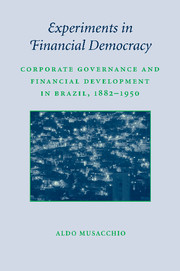 Experiments in Financial Democracy
Experiments in Financial Democracy Book contents
- Frontmatter
- Contents
- List of Figures and Tables
- Preface
- Acknowledgments
- 1 Introduction
- 2 Financial Development in Brazil in the Nineteenth Century
- 3 The Stock Exchange and the Early Industrialization of Brazil, 1882–1930
- 4 The Foundations of Financial Democracy: Disclosure Laws and Shareholder Protections in Corporate Bylaws
- 5 Voting Rights, Government Guarantees, and Ownership Concentration, 1890–1950
- 6 Directors, Corporate Governance, and Executive Compensation in Brazil, c. 1909
- 7 Bond Markets and Creditor Rights in Brazil, 1850–1945
- 8 Were Bankers Acting as Market Makers?
- 9 What Went Wrong after World War I?
- 10 The Rise of Concentrated Ownership in the Twentieth Century
- 11 Conclusion
- Bibliography
- Index
- STUDIES IN MACROECONOMIC HISTORY
1 - Introduction
Published online by Cambridge University Press: 30 January 2010
- Frontmatter
- Contents
- List of Figures and Tables
- Preface
- Acknowledgments
- 1 Introduction
- 2 Financial Development in Brazil in the Nineteenth Century
- 3 The Stock Exchange and the Early Industrialization of Brazil, 1882–1930
- 4 The Foundations of Financial Democracy: Disclosure Laws and Shareholder Protections in Corporate Bylaws
- 5 Voting Rights, Government Guarantees, and Ownership Concentration, 1890–1950
- 6 Directors, Corporate Governance, and Executive Compensation in Brazil, c. 1909
- 7 Bond Markets and Creditor Rights in Brazil, 1850–1945
- 8 Were Bankers Acting as Market Makers?
- 9 What Went Wrong after World War I?
- 10 The Rise of Concentrated Ownership in the Twentieth Century
- 11 Conclusion
- Bibliography
- Index
- STUDIES IN MACROECONOMIC HISTORY
Summary
At the end of 2007, the financial press celebrated that the São Paulo Stock Exchange (Bovespa) had successfully promoted the issue of new shares for 27 companies in that year alone. Abetted by low interest rates and improvements in corporate governance, corporations in Brazil had accomplished what seemed to be an all-time record number of initial public offerings (IPOs) in a single year. 1 Yet, Brazil experienced a period of relative stability in interest rates and intense activity in stock markets before 1920 that by some measures represents even more of an historical peak than today's boom. Many of the better years between 1890 and 1913 saw more than 30 new initial public offerings of stock on the Rio de Janeiro and São Paulo stock exchanges combined. Moreover, both the number of traded companies per million people (a common measure of stock market development) and the capitalization of corporate bond issues to gross domestic product (GDP) were nearly twice at the beginning of the twentieth century than they are today. How did Brazil develop such an impressive market for corporate securities – perhaps even more impressive than today's market – before World War I?
This book examines the institutional conditions that prevailed at the turn of the twentieth century when Brazilian companies were selling large amounts of equity and bonds to foreign and domestic investors. The argument of the book is that in a relatively favorable macroeconomic environment, with significant flows of external capital, Brazilian corporations were able to attract large numbers of shareholders and bondholders by providing protections against potential mismanagement and abuse by managers and insiders.
- Type
- Chapter
- Information
- Experiments in Financial DemocracyCorporate Governance and Financial Development in Brazil, 1882–1950, pp. 1 - 27Publisher: Cambridge University PressPrint publication year: 2009
